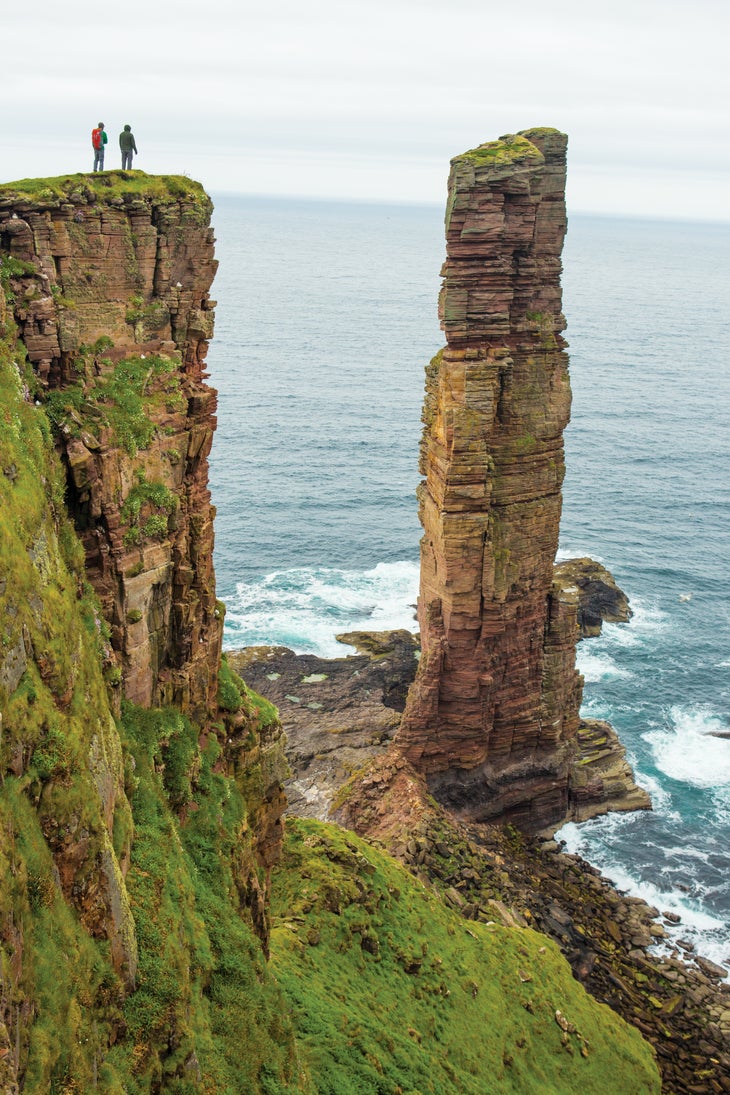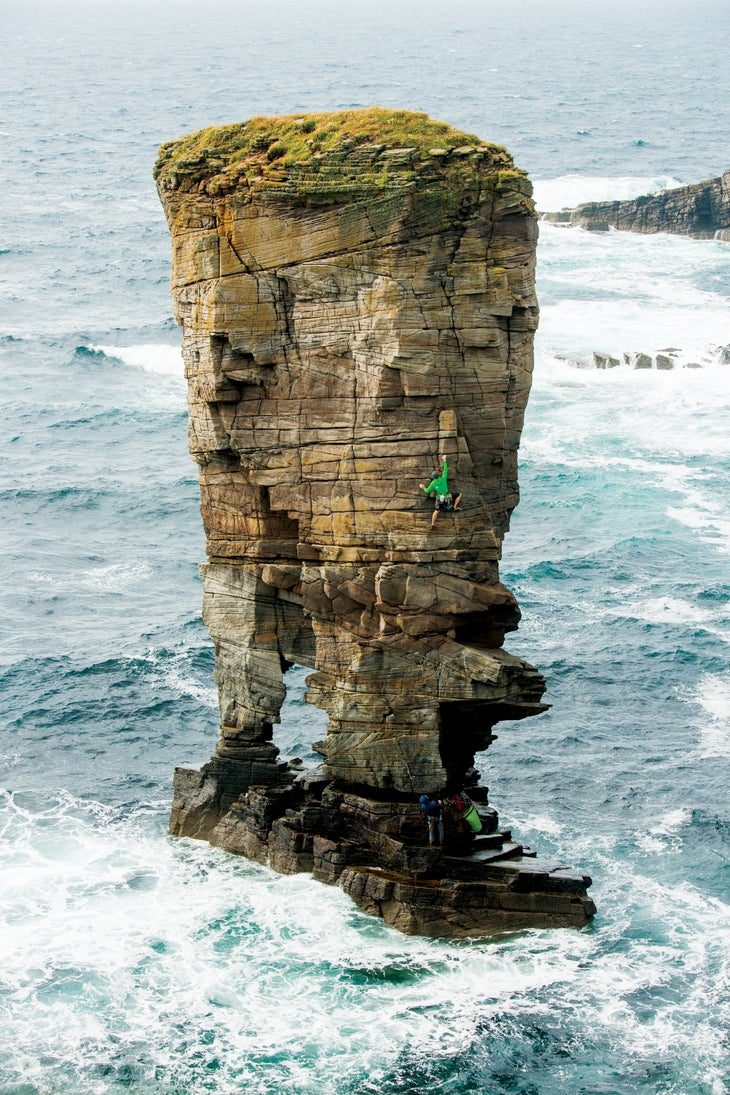Heading out the door? Read this article on the new Outside+ app available now on iOS devices for members! Download the app.

Fear rises and falls in my chest, matching the rhythm of the ever-building swells. I’m sitting on a cliff edge, perched like a gargoyle as I contemplate jumping. Flashes of ocean spray coat the rock, ropes, and my rack. Crystallizing salt takes hold of my eyelashes—until I’m completely doused once again. Not so far in the distance, sea foam swirls up in the air like a maritime dust devil.
With my life jacket securely fastened and a bowline around my waist, I glance at the anchor and the 3-to-1 hauling system we’ve rigged in case all hell breaks loose and I need to be pulled from the grip of Davy Jones’ Locker. I steady myself for a big plunge—the longer I stay and look at the 115-foot Yesnaby Castle, the more fearful I get. A wave rolls by, and I jump into the unknown. Soon, everything is black. This is possibly one of the stupidest things I’ve ever done, and it is certainly the most insane approach to anything I’ve ever climbed.
We’d arrived in Scotland two days earlier, planning to climb its legendary sea stacks and stand atop as many as we could within a week’s time. Number one on our list, and one that belongs on every adventure climber’s hit list, was the Old Man of Hoy, Scotland’s most famous. Turns out, though, it isn’t a sea stack at all, disqualified by a narrow ribbon of land connecting it to the isle well above the high-tide line. A proper sea stack, we soon learned from locals, is completely surrounded by the sea, at least when the tide is in. The Old Man of Hoy has been granted a certain amount of lenience, I suppose, out of respect. After all, it’s the biggest of all of Great Britain’s roughly 300 sea stacks. Many of these, like the Old Man, guard the coastline of Orkney, a cluster of islands off Scotland’s northern tip, like the ramparts of a medieval castle.

The trail to the Old Man from Rackwick Bay on the island of Hoy winds up a hillside and then crosses three miles of boggy marshes atop St. John’s Head, which rises to a height of 1,150 feet, the tallest cliff in all of the U.K. Steep, treacherous grass slopes lead down to the base of the Old Man and are often the crux of a would-be climber’s day, especially when they’re wet—and they’re almost always wet. Miraculously for us, they were dry.
The tower is composed of rock with the is-what-it-is name of Old Red Sandstone. The hues, the texture, and even the grains of sand reminded me of the Wingate layers winding their way through the desert Southwest. As a Utah-based climber, I felt right at home. From the approach, the Old Man looks like a Cubist vision of Castleton Tower, but taller, skinnier, and more majestic. If it weren’t for the rolling seas and vomiting birds (more on that in a moment) you might be able to trick yourself into believing you were far from a small island in the Atlantic.
We sent pitch by enjoyable pitch—four in total—connecting ledge systems via familiar stemming and hand jamming, the toughest being a short section of overhanging blue-collar fists clocking in at 5.9. We also learned a new skill: how to dodge the projectile hurl of nesting fulmars, a pearly white seabird with a repugnant defense mechanism (yacking an oily substance on its intruders). On the summit we hunkered down to keep out of a building wind and watch puffins defy the laws of physics, hovering in place for minutes at a time.

Back in postcard-worthy Rackwick Bay, we retreated to the dimly let Burnmouth Cottage, known to climbers as the “bothy bivy,” an ancient tenant farmer’s house where you can cook and camp for free. Over farm-fresh mutton, haggis, and (of course) a wee dram of Scottish whisky, we planned our next objective: Yesnaby Castle. This short but imposing tower is always completely surrounded by water, a true sea stack.
After a half-day of ferries, driving, and walking, we peered over the cliff’s edge and viewed a horrifying scene: Yesnaby was completely surrounded in a churning, foamy-white washing machine of deadly chaos. The sea was angry, as they say here. We tucked tail and turned back to town to take a rest day and look for a boat. Not a strange quest, I figured, this being an island and all. But we were met with amused, bewildered looks and requests for more information.
“We want to go climb North Gaulton Castle and Yesnaby—ya know, the sea stacks?” I explained. “I think they put a car on top of one of them in the 1980s for an advertisement.”
“Whatcha wanna do that for? Are you daft? Let me rephrase myself: You are completely daft!” the harbormaster blustered, so as not to give the option of answering.

Being resourceful climbers, we altered our plans, and after a day of searching and securing a life jacket, I finally jumped into the cold, black sea for a swimming approach.
Splashdown. It was farther than it looked, but I wasn’t held under for long as the buoyant jacket had me bobbing like a cork. I was surprised the water wasn’t colder; it was actually somewhat pleasant. Maybe I was warmed by adrenaline. I don’t fancy myself much of a seaman, but the time I’ve spent in the ocean has fostered a great, humbling respect for the sea, and I knew I shouldn’t be there for long.
The current was strong, and the vertical gain between the trough and peaks of the swell was far greater than it appeared from above. Somehow I crossed the channel and pulled up onto the wave-splashed platform before getting sucked back in. I finally secured myself at the tower’s base and rigged a Tyrolean to shuttle people and gear. An hour later, we had finished the approach to our first proper sea stack.

The climbing, in comparison, was smooth sailing. We chose the easiest path, following Original Route (E2 5b/5.10) for the first bit, and then striking out right to a beautiful arête (East Arête, E1 5b/5.10). The sandstone, grayer and more compact than the Old Red variety of Hoy, proved to be just as solid, if not more. Horizontal edges hidden from below provided excellent holds, and the matrix of small, shallow cracks accepted plentiful gear. I wish as much could be said for the rappel anchor, but a piece of rusty steel pounded into the turf is as good as it gets around here.
After returning to shore and recounting these stories to Neil, the harbormaster, he repeated his assertion that I was daft. But he also had a greater appreciation for our request for a boat (and our disinclination to go swimming again). He informed me that what we really needed was a dinghy, not a boat, as no captain on this isle would get his vessel close enough to the rock to eliminate the swim.
Scouring the docks, we located a small, inflatable two-person raft—like one that you might find at Wal-Mart—lashed to a dilapidated pallet. We deflated the dinghy and readied it for transport.

Atop the bluff near Mouseland Farm (which really isn’t a farm at all these days but simply a name that persists), we blew up the dinghy, drove a rappel stake (salvaged from the axle of a tractor) into the turf for an anchor, and headed over the edge.
Rappelling out of the sky and into the raft felt James Bond–like, and once we paddled into the channel, our ship felt quite stable. We reached the base with relative ease (compared to swimming, anyway).
Now, established on the sea stack known as the North Gaulton Castle, we noticed that the rising tide would quickly submerge our platform. My partner, Peter Vintoniv, quickly busted out 10 feet of spicy and runout 5.9 moves with wet chalk and even wetter shoes to reach a proper, dry belay ledge. Those moves turned out to be the most difficult of the climb, and while the remaining 150 feet of sandstone, mudstone, and shale appeared chossy from below, it proved to be completely solid and provided wonderful 5.7-ish climbing. A true classic in every sense.
With our sea-stack climbing system dialed, we ticked off two more stacks in the following days: Stackabank and Clett of Crura (though they weren’t that good), and then left Orkney.

After a day’s drive on super twisty, small roads through the beautiful northern Scottish landscape, we arrived at the Point of Stoer showered in the sunny golden goodness of high-latitude afternoon light. Here lies Scotland’s other famous Old Man, and after the solitude of Orkney, we were not alone. We passed parties on the walk over the headlands—seven in all—some of whom had started at 6 a.m. But you couldn’t blame them: Sunny Saturdays in Scotland don’t happen all that often.
Sheltered seas, blistering temps, and a small channel enabled us to take our guard down for the first time, and we were actually able to enjoy the swim, as evidenced by Peter’s backflip entry.
We started up the Old Man of Stoer on a brilliant four-pitch 5.8 (Original Route) that winds its way up the spire via ledges and cracks, with multiple options for protection at every turn. But we’d forgotten the topo in the car and soon got off-route, lost in a maze of options. It was 10 p.m. by the time we finished, but still light. We were engulfed in the brilliance of the setting sun as we strolled back across the bogs.
Our last day—and one more tower to go. The last of our seven sea stacks would be Am Buachaille. Like the Old Man of Stoer, this too is sculpted from Torridonian sandstone. Most climbers wouldn’t care or even notice, but it’s rare to be climbing on sandstone so old—Precambrian in fact. After a calm swim to the base, I grabbed the ancient holds, geeked out, and climbed up.

Ticklist
- Old Man of Hoy, for its height and prowess: At 449 feet, it’s one of the tallest sea stacks in the world and sees only about 20 ascents per year.
- Old Man of Stoer, for the high-quality rock: First climbed in 1966 by sea-stack legend Tom Patey, it’s regarded by many as the best of the “old men.”
- Yesnaby Castle, for the swim, of course: Just 115 feet tall, but what it lacks in height it makes up in quality.
- North Gaulton Castle, for not falling over when they put a car on top: Logistically tricky, but good fun. Sees few ascents.
Plan It
Get there
Fly into Glasgow, or Manchester if tickets are cheaper. You’ll need a rental car to access the far-flung stacks. Hint: Spring for the GPS.
Ferry
To reach Orkney, you’ll need to hop a ferry. Take Northlink’s Scrabster to Stromness route (northlinkferries.co.uk); you’ll float right by the Old Man of Hoy on your way. Or save some scratch with budget-oriented Pentland (pentlandferries.co.uk) on the Gills Bay to St. Margaret’s Hope route. Either way, once on the Mainland (Orkney’s largest island), you’ll need a second ferry (Stromness to North Hoy) to reach the Old Man of Hoy (orkneyferries.co.uk).
Camping
On the mainland, you can generally find wild camping near the car park for your objective. For Old Man of Hoy, stay at the Burnmouth Cottage (scottishcampingguide.com), which is beside the approach.
Beta
Visit Mountain Project for Old Man of Stoer and Old Man of Hoy.